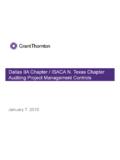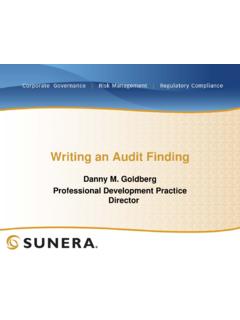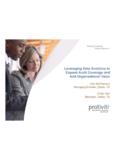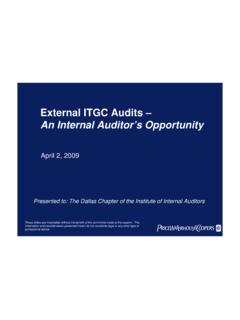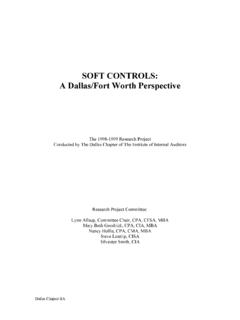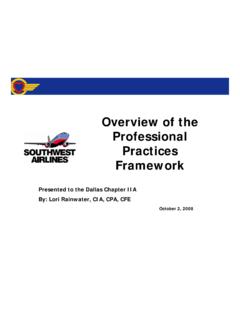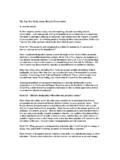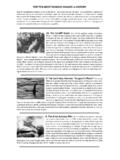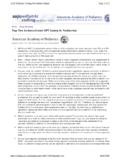Transcription of Top Ten Issues facing Internal Auditing in the Future
1 Top Ten Issues facing Internal Auditing in the Future The IIA Dallas Chapter April 6, 2006. Presented by: David A. Richards, CIA, CPA. President The Institute of Internal Auditors 1 Agenda What should Internal Auditors do? Top Ten areas for Internal auditors to focus on for the Future How can The IIA help? 2 Definition of Internal Auditing : Internal Auditing is an independent, objective assurance and consulting activity designed to add value and improve an organization's operations. It helps an organization accomplish its objectives by bringing a systematic and disciplined approach to evaluate and improve the effectiveness of the risk management, control and governance processes.
2 (Approved by the Board of Directors 6/26/99). 3 What do Internal Auditors Do? Help solve problems Confirm accuracy of information Ensure assets are properly safeguarded Confirm compliance to laws &. regulations Help improve the effectiveness and efficiency of processes Investigate fraud situations Provide a resource for skills 4 What are our Constituents saying about us? Communication needs improvement (AC, Mgt, EA). Focus needs better alignment Resources/skills need assessment Top areas for attention: control, risk, fraud, IT. Assessment of results presentation 5 Where are we now??? What Image do we have?
3 What type of Outputs do we produce? What Process do we follow? What ability do we have to control the Future ? What indicators do we have of how we are doing? 6 Where are we now??? Image Corporate cop . Compliance focused Partner Source of value creation Involved in corporate initiatives Customer focused 7 Where are we now??? Outputs Findings / causes Recommendations Implementation help Post implementation verification /. confirmation of results that resolve Issues Anticipate customer needs 8 Where are we now??? Process Cycle Risk based Customer input Customer focused / driven Competitive (Bid).
4 Proactive vs. reactive 9 Agenda What should Internal Auditors do? Top Ten areas for Internal auditors to focus on for the Future How can The IIA help? 10 #1:Fraud Audit Techniques 11 Fraud Responsibilities Internal Auditing Fraud risk identification & response Investigating Fraud cases Fraud consideration in each audit Support Hot Line Support Education & Training Help Ethics Officer Fraud Program Help establish Corporate Compliance Program 12 Fraud Aspects Awareness Training Identification Investigation 13 #2:Technology Expertise 14 Assessing IT Controls Understanding IT Controls Governance, Management, Technical General / Application Preventive, Detective, Corrective Information Security Importance of IT Controls Roles & Responsibilities for IT Controls Based on Risk Monitoring techniques Assessment Process 15 GAIT Scoping Example Forfinancial reporting, the scope of IT control testing has three primary axes: What business processes are in scope?
5 Which business processes are relevant to financial reporting ( , materiality)? How significant is the business process to the financial reporting objective? What other transactional controls exist that may create assurance of the business process integrity ( , manual settlement and balancing)? Example: 10 revenue generating systems; external auditors won't look at all 10, but will concentrate on the 3 that compose 85%. For those business processes in scope, what IT assets are considered relevant to financial reporting ( , distance and percentage of controls embedded in IT)? Example: 10 revenue generating systems; external auditors won't look at all 10, but will concentrate on the 3 that compose 85% of the overall revenues.
6 What level of controls evaluation and testing is required to create sufficient assurance for management to make the assertions related to IT change and IT. entitlements transactions ( , completeness, accuracy, etc.)? What are the types of controls in place? The level of assurance goes from highest to lowest, in the following order: automated and preventive automated and detective: manual and preventive manual and detective 16 #3:Governance Auditing 17 Governance Key Words Expectations What is needed for Success: Policies, procedures, guidance, organization, assignment of responsibilities Communications Informing & Training Accountability holding people accountable for meeting expectations 18 IIA Standards-Governance 2130-Governance The Internal audit activity should contribute to the organization's governance process by evaluating and improving the process through which (1) values and goals are established and communicated, (2) the accomplishment of goals is monitored, (3) accountability is ensured, and (4)
7 Values are preserved 19 Allocation of IA Effort Best Practice reviews Audit Effort Perfo rm au dits o speci effecti f des venes i gn &. fic go s of verna nce p roces ses Provide advice with focus on Establishing Governance Structure Less Structured More Structured Governance Model 20 What Should IA Do? Setting Expectations: IA should: -- Help drafting of policies, procedures, processes, guidance to utilize their - knowledge - expertise -- Ensuring Controls are build into processes not added on 21 What Should IA Do? Communicate: IA should: -- Assist in training programs on - Ethics - Risk identification - Control options - Fraud awareness -- Design programs -- Participation in training sessions 22 What Should IA Do?
8 Accountability: IA should: -- Perform objective assessments using systematic, disciplined approach that incorporates an evaluation of evidence -- Ensure compliance to management directives by comparison of actual to criteria -- Assist in evaluation of processes to ensure efficient operations and effective accomplishment of objectives 23 #4: Internal Control Assessment &. Opinion 24 Control Defining Key Controls Assessing Control Effectiveness Opinion 25 Control A Process Effected by an Entity's Board of Directors, Management and Other Personnel, Designed to Provide Reasonable Assurance regarding the Achievement of Objectives in the following categories: --Effectiveness & Efficiency of Operations --Reliability of Financial Reporting --Compliance with Applicable Laws &.
9 Regulations --Safeguarding of Assets COSO Definition 26 Opinion on IC. Evaluation criteria & structure Scope Who has responsibility for IC. Type of opinion Positive assurance Binary Graded Directional Negative assurance Qualified 27 Issues Estimates Closing Process Journal Entries Reconciliations Assignment of Responsibilities Accountability Ethics Risk Assessment Governance (Principles). IT Controls Analysis & Monitoring 28 #5:Risk Assessment Approach 29 5. Risk Assessment Knowledge Use Reporting Audit Committee & Risk ERM & IA. 30 Definition IIA Research Report A rigorous and coordinated approach to assessing and responding to all risks that affect the achievement of an organization's strategic and financial objectives.
10 This includes both upside and downside risks. 31 Key Concepts Premises ERM enables management to effectively deal with uncertainty and associated risk and opportunity, enhancing the capacity to build value 32 Core Roles for IA on ERM. Giving assurance on risk management processes. Giving assurance that risks are correctly evaluated. Evaluating risk management processes. Evaluating the reporting of key risks. Reviewing the management of key risks. 33 Roles IA Can Do Facilitating identification and evaluation of risks. Coaching management in responding to risks. Coordinating ERM activities.
